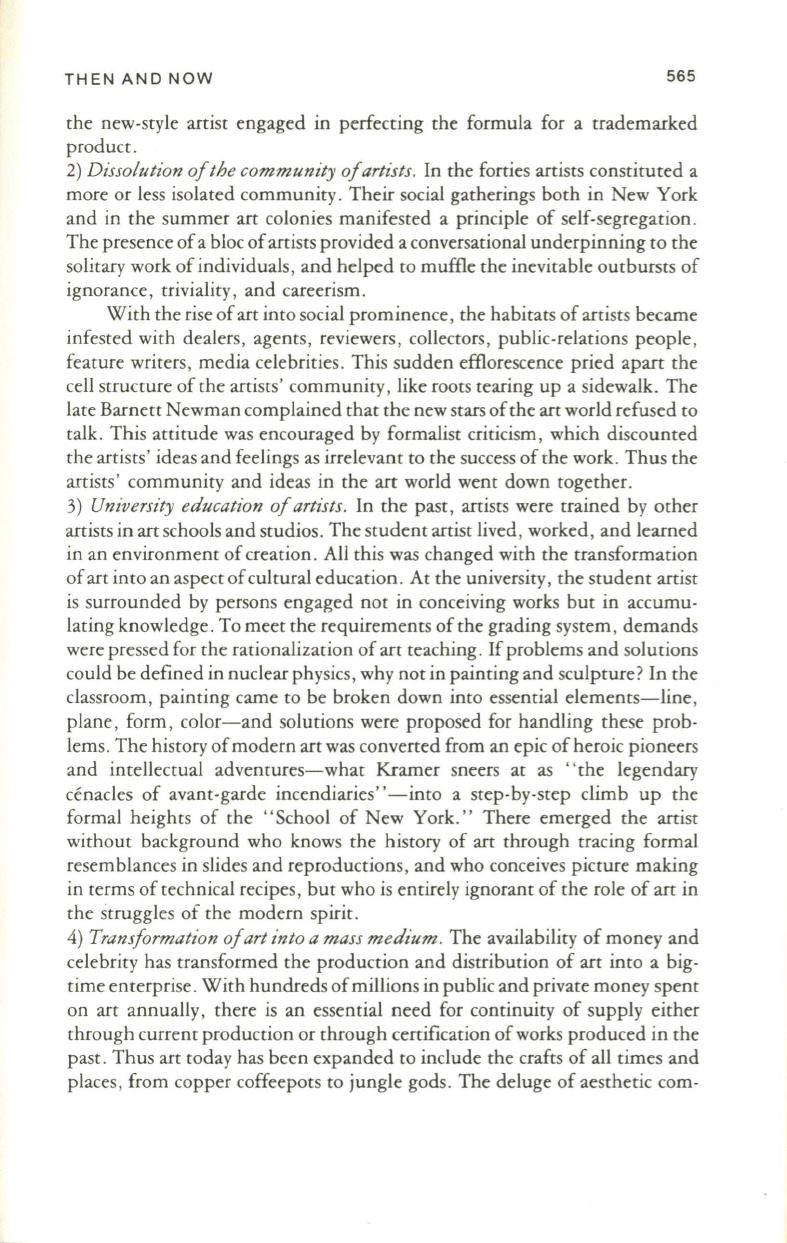
THEN AND NOW
565
the new-style artist engaged in perfecting the formula for a trademarked
product.
2) Dissolution ofthe community ofartists.
In the forties artists constituted a
more or less isolated community. Their social gatherings both in New York
and in the summer art colonies manifested a principle of self-segregation.
The presence of a bloc ofartists provided a conversational underpinning to the
solitary work of individuals, and helped to muffle the inevitable outbursts of
ignorance, triviality, and careerism .
With the rise ofart into social prominence, the habitats of artists became
infested with dealers, agents, reviewers, collectors, public-relations people,
feature writers, media celebrities. This sudden efflorescence pried apart the
cell structure of the artists' community, like roots tearing up a sidewalk. The
late Barnett Newman complained that the new stars of the art world refused to
talk . This attitude was encouraged by formalist criticism, which discounted
the artists' ideas and feelings as irrelevant to the success of the work . Thus the
artists' community and ideas in the art world went down together.
3) University education ofartists.
In the past, artists were trained by other
artists in art schools and studios. The student artist lived, worked, and learned
in an environment of creation. All this was changed with the transformation
of art into an aspect ofcultural education. At the university, the student artist
is surrounded by persons engaged not in conceiving works but in accumu–
lating knowledge . To meet the requirements of the grading system, demands
were pressed for the rationalization of art teaching. If problems and solutions
could be defined in nuclear physics, why not in painting and sculpture? In the
classroom, painting came to be broken down into essential elements-line,
plane, form , color-and solutions were proposed for handling these prob–
lems . The history ofmodern art was converted from an epic of heroic pioneers
and intellectual adventures-what Kramer sneers at as "the legendary
cenacles of avant-garde incendiaries" -into a step-by-step climb up the
formal heights of the "School of New York." There emerged the artist
without background who knows the history of art through tracing formal
resemblances in slides and reproductions, and who conceives picture making
in terms of technical recipes, but who is entirely ignorant of the role of art in
the struggles of the modern spirit .
4) Transformation ofart into a mass medium.
The availability of money and
celebrity has transformed the production and distribution of art into a big–
time enterprise. With hundreds ofmillions in public and private money spent
on art annually, there is an essential need for continuity of supply either
through current production or through certification of works produced in the
past . Thus art today has been expanded to include the crafts of all times and
places, from copper coffeepots to jungle gods. The deluge of aesthetic com-


